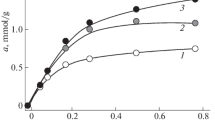Summary
Selective chelating exchangers on the basis of polystyrene with the following anchor groups are characterized by capacity, determination of exchange rates and of distribution coefficients: 4,5-dihydroxynaphthalenedisulphonic acid-(2,7) (chromotropic acid), alizarin, 1,2,5,8-tetrahydroxyanthraquinone (quinalizarin), morin, 1,5-diphenylthiocarbazone (dithizone), 1,5-diphenyl-carbazide, glyoxalbis(2-hydroxyanil), 1-[thenoyl-(2′)]-3,3,3-trifluoroacetone (TTA), 5-(4-dimethylaminobenzylidene)-rhodanine (DMABR), ethylenediamine-N,N′-bis-(o-hydroxyphenylacetic acid) (Chel I), 1,2,3-trihydroxybenzene (pyrogallol), 4-methoxy-2-[thiazolyl-(2)-azo]-phenol (TAM), bis-salicylidene)-1,2-diaminoethane (Salen), 8-hydroxyquinoline, pyrocatecholdisulphonic acid-(3,5) (Tiron). The capacity values of the chelating polystyrene exchangers with grain sizes of 0.1–0.2 mm vary between 0.4 and 1.5 mmol/g. It can be expected that these exchangers will have more favourable separation properties than the commercially available exchanger Dowex A-1.
Zusammenfassung
Selektive Chelataustauscher auf der Basis von Polystyrol mit folgenden Ankergruppen werden durch Kapazitätsbestimmung, Messung der Austauschgeschwindigkeit und Bestimmung der Verteilungskoeffizienten charakterisiert: 4,5-Dihydroxynaphthalindisulfonsäure-(2,7) (Chromotropsäure), Alizarin, 1,2,5,8-Tetrahydroxyanthrachinon (Chinalizarin), Morin, 1,5-Diphenylthiocarbazon (Dithizon), 1,5-Diphenylcarbazid, Glyoxal-bis(2-hydroxyanil), 1-[Thenoyl-(2′)]-3,3,3-trifluoraceton (TTA), 5-(4-Di-methylaminobenzyliden)-rhodanin (DMABR), Ethylendiamin-N,N′-bis-(o-hydroxyphenylessigsäure) (Chel I), 1,2,3-Trihydroxybenzol (Pyrogallol), 4-Methoxy-2-[thiazolyl-(2)-azo]-phenol (TAM), Bis-(salicyliden)-1,2-diaminoethan (Salen), 8-Hydroxychinolin, Brenzcatechindisulfonsäure(3,5) (Tiron) Die Werte für die Kapazität der chelatbildenden Polystyrolaustauscher mit einer Korngröße von 0,1–0,2 mm variieren zwischen 0,4 und 1,5 mmol/g. Es ist zu erwarten, daß diese Austauscher teilweise wesentlich bessere Trenneigenschaften aufweisen als der handelsübliche Austauscher Dowex A-1.
Similar content being viewed by others
Literatur
Griesbach, M., Lieser, K. H.: Angew. Makromolekulare Chem., im Druck
Houben-Weyl: Methoden der organischen Chemie 10/3, S. 131 u. 137. Stuttgart: Thieme 1965
Leyden, D. E., Underwood, A. L.: J. Physic. Chem.68, 2093 (1964)
Lieser, K. H., Zuber, G.: Angew. Makromol. Chem.57, 183 (1977)
Author information
Authors and Affiliations
Rights and permissions
About this article
Cite this article
Griesbach, M., Lieser, K.H. Eigenschaften von chelatbildenden Ionenaustauschern auf der Basis von Polystyrol. Z. Anal. Chem. 302, 109–114 (1980). https://doi.org/10.1007/BF00580401
Received:
Issue Date:
DOI: https://doi.org/10.1007/BF00580401



